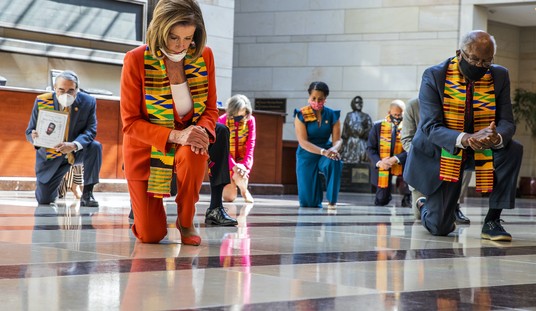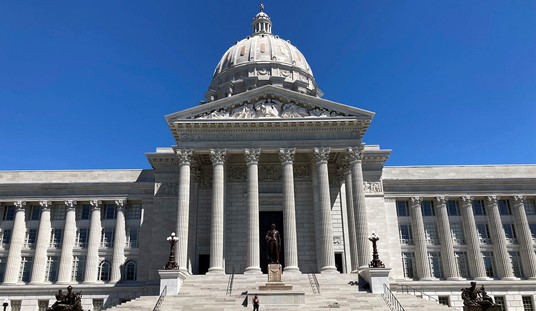
I have frequently criticized liberal and Democratic commentators for relying on the Static Electorate Fallacy, the idea that the 2016 electorate and results will not stray far from the demographic, geographic and ideological contours of 2012, despite longstanding American electoral history showing that elections following the re-election of an incumbent have always featured shifts in the map to the detriment of the party in power. Candidates make their own turnout, and removing a successfully re-elected incumbent always puts more voters and potential voters up for grabs.
But conservative and Republican commentators need to avoid believing our own comforting myths, and one of those has managed remarkable durability even though it should have gone away within a month of the 2012 elections: that something like 4 million usually reliable conservative voters – voters who showed up at the polls even in the down year of 2008 to support John McCain – stayed home in 2012 because Mitt Romney was too moderate. This theory keeps getting offered as proof that all the GOP needs to do is nominate a real conservative and this cavalry, 4 million strong, will come charging over the hilltop and save the day. In fact, poor a candidate as he was, Romney actually got more votes than McCain did; the belief that he got less is based entirely on incomplete numbers reported in the first 24-48 hours after Election Day, before all the votes had finally been counted.
The Myth
The myth itself first appeared shortly after the November 6, 2012 election. Here’s Jeffrey Lord in the American Spectator:
On Tuesday night, it comes clear, as this is written using the latest Fox News figures, Mitt Romney lost to President Obama by 2,819,339 votes.
And the news ekes out that Moderate Nominee Number 10 Romney received some 3 million Republican votes less than Moderate Nominee Number 9 — John McCain in 2008.
Which is to say, 3 million base GOP voters simply refused to vote for Romney. Doing the available math, that means had those 3 million Republicans voted for Romney he would have, as this is written, a margin of victory in the national popular vote of 180,661.
Here’s Rush Limbaugh the same day:
So three million Republican voters stayed home on Election Day. Three million predominantly white voters stayed home. The media is all over the place with the fact that the Republicans lost “the white vote.” They can’t get the white vote. They did lose the white vote, but Democrats didn’t get it. They just didn’t show up, and it wasn’t voter suppression that didn’t turn ’em out.
What would be the reason that three million voters didn’t show up? Let’s go through the possibilities. It could be that there are a number… We’ve talked to ’em. We’ve had ’em call. We got ’em, in fact, on hold. A number of Republicans are tired of moderate nominees. They’ve sent the Republican Party money for years and said, “To hell with it. If you’re gonna eschew conservatism, I’m not giving you any money, and I’m not voting for you.”
Here’s Andrew McCarthy at National Review, on November 10:
Somehow, Romney managed to pull nearly 2 million fewer votes than John McCain, one of the weakest Republican nominees ever, and one who ran in a cycle when the party had sunk to historic depths of unpopularity. How to explain that? The brute fact is: There are many people in the country who believe it makes no difference which party wins these elections.
Here at RedState, diarist Griffin offered a similar take on November 14, under the title “What went wrong in 2012? The case of the 4 million missing voters”:
Over 62 million voters cast their ballot for George W. Bush in 2004. Less than 60 million voters cast their ballot for John McCain in 2008. And somewhere under 57-59 Million voters cast their ballot for Mitt Romney in 2012. The numbers from the latest election seem to indicate that the Republican Party is losing voters while America is gaining them.
These were preliminary analyses, and Griffin in particular cautioned that they were based on non-final numbers. That’s fine; all of us who do punditry after an election work with the best data we have. The problem is, this became an article of faith for too many people long after the final numbers were available. The 4 million figure shows up in comments sections and on Twitter all the time, and there are still some prominent voices citing it as if it was quantifiable fact. Rush has kept repeating it for years, like this in March 2014:
The 2010 turnout was not duplicated in 2012. But what about the 2012 turnout stands out to you? What stands out to me is that four million Republicans didn’t vote in 2012. Four million stayed home, for whatever reason. I said, it seems to me that if those four million had shown up, we would have won, and we would have won by turning out our base.
[L]o and behold, when 2012 came around, the people that made the 2010 midterm landslide possible stayed home. Remember those four to five million Republicans that did not vote in 2012? They did not show up for Romney. And in 2008 they did not show up for McCain. They show up in the midterms, they stay home.
Since 2008 and 2012 turnout was by any measure higher in absolute terms in all groups than the 2010 and 2014 midterms, I’m not sure that’s even a relevant comparison, but leave that aside. Here’s Emmett “Bob” Tyrell of the American Spectator in February 2015:
We conservatives have learned a lot from Obama’s election and from his re-election in 2012. The election of 2012 was but a rerun of 2008 with four million conservatives absent…Four million conservatives took a vacation from history in 2012 and the results were four more years of a papier-mâché president. It will not happen again.
Here’s Craig Shirley in April 2014, speaking to CNS News:
“In 2012, four million conservatives stayed home. And in 2006, the last time Republicans controlled the House and Senate, 1 out of 5 self-identified conservatives didn’t vote to punish the Republican Party.”
American Thinker in November 2013:
Obama won by only 5 million votes. Three million Republicans didn’t vote in the 2012 Obama-Romney face-off and a hefty number of disgruntled Republicans voted for libertarian Gary Johnson, who garnered 1.5 million votes. Millions of conservatives — who are not registered Republicans — also withheld their votes. Imagine if all of those protest votes had gone to Romney?
Shreveport Times just last month:
There’s probably a lot of folks out there right now who would just as soon stay at home on election day. In fact, that’s what happened in the 2012 presidential election. For Republicans, it is estimated that as many as four million conservative voters just stayed home on election day and didn’t show up.
What sounds like the most extreme version of this – more on this below – is from [mc_name name=’Sen. Ted Cruz (R-TX)’ chamber=’senate’ mcid=’C001098′ ], who keeps citing a number ten times that in his stump speeches:
“The last election, 2012, 54 million evangelicals stayed home. Fifty-four million,” the GOP presidential candidate told the crowd of about 1,500. “Is it any wonder the federal government is waging a war on life, on marriage, on religious liberty when Christians are staying home and our leaders are being elected by nonbelievers?”
You can watch him give a speech citing that figure here. And here is Ralph Reed, last month:
Ralph Reed, founder and chairman of the Faith & Freedom Coalition, told the crowd that evangelical Christians made up 27% of the electorate in 2012, a presidential year, and 32% of voters in the 2014 midterm elections.
Yet as many 17 million evangelicals stayed home in 2012, he added, an election in which President Obama beat Mitt Romney by some 5 million votes.
The Reality
To the extent that any of these analyses are based on the proposition that Romney got millions fewer votes than McCain, they are provably wrong. What happened is pretty simple: some states and localities take longer to count the votes than others – some big cities are notorious for this, some count absentee ballots slowly, California traditionally counts very slowly, and some of the jurisdictions hit hard by Hurricane Sandy in 2012 were understandably slow getting finalized. But the final numbers are not what was originally available in the immediate aftermath of the election:
In 2004, George W. Bush got 62,039,572 votes vs 59,027,115 for John Kerry.
In 2008, John McCain got 59,950,323 votes vs 69,499,428 for Barack Obama – in other words, McCain lost about 2 million votes from what Bush had received, while Obama gained over 10 million vs Kerry’s total.
In 2012, Mitt Romney got 60,934,407 votes vs 65,918,507 for Obama – a million more votes for Romney than McCain, and 3.5 million fewer for Obama (but still up around 6 million compared to Kerry).
Presumably, some of Bush’s voters in 2004 stayed home in 2008 and 2012, while others switched to Obama or one of many minor third party candidates. But even if we compare Romney to Bush, he’s off by only a little over a million votes, not such an enormous number in an electorate of around 130 million people. And exit polling doesn’t really support the notion that self-identified conservatives were noticeably missing, as Karl Rove noted in the Wall Street Journal back in April:
According to exit polls, self-identified conservatives made up 35% of the 2012 turnout, and 82% of them voted for Mr. Romney. This translates into about 45.2 million conservatives who turned out—roughly 531,000 more than in 2008.
In 2008 conservatives were 34% of the turnout, and 78% voted for John McCain. So Mr. Romney got around 2.2 million more conservative voters than Mr. McCain—and the conservative share of the 2012 electorate was the highest since exit polls began asking voters about their political leanings in 1976.
The Actual Opportunity
So, the cavalry isn’t coming. The number of people who voted for a past Republican presidential candidate and not for Mitt Romney likely isn’t be much above the 1 million to 1.5 million range, not enough by itself to cover the distance between Romney and Obama, and the missing stay-at-home voters did not appreciably cut into the proportion of voters who think of themselves as “conservatives.”
But this doesn’t mean the electorate really is static, or that there’s no opportunity to improve on it. What it means is that the missing potential Republican voters are mostly people who have not been regular voters in the recent past, and many of them may not be politically engaged people who think of themselves as conservatives, whether or not their actual beliefs are. Let’s start with the fact that about 93 million eligible voters didn’t vote at all in 2012:

By no means are all of those reachable voters; the annual trendline shows pretty convincingly that you’ll never get all of them to show up, nor would you want to. But it’s a deep pool, and as this chart from my 2014 piece at The Federalist shows, the total vote tends to grow a lot faster for the party out of power after an incumbent re-election (the “Ch TO” column) than it does for either party in the previous election – the party out of power increased its vote total by at least 11.3% in every post-incumbent election from 1868 to 2008 except three elections where there was another incumbent on the ballot (1904, 1944, and 1948 – the chart splits off the elections where there was an incumbent running):

Where might those votes come from? When PoliFact challenged Cruz’s “missing evangelicals” number, his spokesman offered this:
By email, Cruz campaign spokesman Rick Tyler said Cruz reached his “roughly half” conclusion starting from a 2007 survey by the non-partisan Pew Research Center indicating 26.3 percent of American adults identified as evangelical Protestants. The center conducted a “nationally representative sample of 35,556 adults living in continental United States telephone households” from May 8, 2007 to Aug. 13, 2007.
Apply that result to the U.S. Census Bureau’s estimate of adults who were eligible to vote in 2012, 215 million, Tyler wrote, and it looks like nearly 57 million of citizens eligible to vote in 2012 belonged to evangelical Protestant churches. Separately, he pointed out, Pew cited voter exit polls taken for news organizations to conclude 23 percent of the nation’s November 2012 voters were white evangelical Protestants. Given that 129 million voters participated that fall, Tyler said, that means there were about 30 million evangelical Protestant voters, which would have been about half of the evangelical Protestants eligible to vote.
If you credit Tyler’s math, you get around 27 million missing evangelical Protestants, which is roughly half Cruz’s 54 million number but much larger than Reed’s 17 million. 54 million would mean a heavy majority of the eligible non-voters, which is implausible, plus Tyler’s email makes clear he’s not breaking out those numbers by race, and non-voting black or Hispanic evangelical Protestants – while quite plausibly less overwhelmingly Democratic than their voting brethren – are probably not a heavily majority Republican-friendly group. You can read the rest of the PoliFact “analysis” – as is sometimes the case, it’s a more useful endeavor than reading PoliFact’s “conclusion” – but even if Cruz’s stump speech is off by an order of magnitude, the idea that there are a few million evangelical Christians out there who could be mobilized to vote for the first time is hardly unreasonable and a good place to start.
Rove notes other groups who seem to have been down from 2008 to 2012, including at least one group (white Catholics) that Romney did well with:
There were approximately 4.9 million fewer self-identified moderates, 1.7 million fewer white Catholics, and 1.2 million fewer women who voted in 2012 than in 2008.
There may be factors unique to Romney that caused problems around the edges, as was true of McCain in his own ways – you can read an effort here to extrapolate the potential effects of anti-Mormon bias from some social-science research, and while I don’t find it notably persuasive, there may be some spots on the map where the removal of that factor could open new avenues in 2016. Romney was also more of an immigration hawk than McCain and more identified with personal wealth, while McCain was older, had a more polarizing running mate, a messier personal life, and a markedly less favorable political environment to run in.
Then there’s Sean Trende’s “missing white voters” analysis, which I reviewed back in July 2013 and which you should read in its four-part glory if you want a deep dive into this stuff. Trende’s conclusion was that white-voter turnout rates were down much more than voter turnout among other racial groups in 2012 (other than voters categorized as “other” – if you look at the map, one of the unexplained features of 2012 seems to have been drastically lower Native American turnout than in 2008). Trende concluded from close examination that these were “largely downscale, Northern, rural whites. In other words, H. Ross Perot voters.” Or Donald Trump voters, today, perhaps.
When I looked at Trende’s map, I noted the mixed Electoral College bag in the return on chasing these voters:
[A] good number of the “missing” voters were in uncontested states like New York and Oklahoma where they would not have made a difference. And the big chunks of deep blue in New Mexico, Oklahoma and South Dakota (as well as the heavy dropoff in turnout in Alaska, not shown on the map) are consistent with a dramatic decline in Native American voter turnout.
But a significant number of others were in Pennsylvania (Obama by 309,840 votes out of 5.75 million cast), Ohio (Obama by 166,272 votes out of 5.59 million cast), Michigan (Obama by 449,313 votes out of 4.74 million cast), and Minnesota (Obama by 225,942 votes out of 2.94 million cast). This is consistent with Trende’s conclusion that – while these voters were not, in and of themselves, the cause of Romney’s loss – they were a contributing factor large enough to consider, and one that may loom even larger in a closer future contest between a better Republican candidate and a Democrat who has less visceral appeal to non-white voters. (The lower turnout throughout the Northeast also surely reflects the influence of Hurricane Sandy).
Here’s an overlay of Trende’s district-by-district map (with declining turnout in blue and increased turnout in red) against a map that puts up for grabs the states (and one Congressional district in Nebraska) where one party or the other, mostly the Democrats besides Georgia, North Carolina and Nebraska, won with less than 54% of the two-party vote, so that a 4-point or less shift in that vote could change the outcome:

Realistically, Nevada, Colorado, Florida and Virginia are not states where the GOP candidate in 2016 can shift the electorate just by recovering people who dropped out between 2008 and 2012, although a map against 2004 might be rather a different picture, and those states may be more attuned to Cruz’s idea of digging more deeply for evangelical voters. But Trende’s less religious “missing white voters” could make a bigger impact in New Hampshire, Pennsylvania, Ohio and the Upper Midwest, if the nominee can appeal to them.
Conclusion
No matter who the Republican Party nominates in 2016, there’s a lot of work to be done trying to expand the GOP presidential electorate, whether by appealing to new, young voters, disenchanted Obama 2012 voters, evangelical Christians, working-class white Northerners/Midwesterners, or some other group. History suggests that the opportunity is real, and the task is achievable. The electorate is never set in stone, the battle never over. A clear message, and an appealing candidate who means what he or she says and stands for something and can explain what it is and why, is certainly an important asset in that process. But even then, there’s no magic formula, no cavalry of millions of conservatives waiting just over the hill to save the day, and no single issue or message that will flip the switch. The work will be hard, and will take energy and determination and a whole lot of one-voter-contact-at-a-time labor to register, to activate, to persuade. George W. Bush did that work to get Republicans 11 million new votes from 1996 to 2000, and another 12 million in 2004. Barack Obama did that work to get Democrats 10 million new votes from 2004 to 2008. It will need to be done again.














Join the conversation as a VIP Member